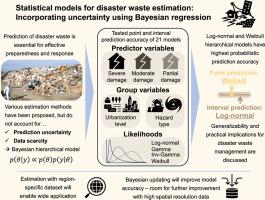灾害废物估计的统计模型:使用贝叶斯回归纳入不确定性
IF 10
1区 环境科学与生态学
Q1 ENGINEERING, ENVIRONMENTAL
引用次数: 0
摘要
准确估计灾害废物的数量对于实现可持续的灾害废物管理至关重要。鉴于以往研究对不确定性考虑不足,本研究旨在建立基于贝叶斯回归的估计模型,通过简单的结构提供包含不确定性的预测。为此,采用交叉验证和概率预测精度、点预测精度和区间预测精度指标,对21个具有不同似然和线性模型的候选模型进行了比较。结果表明,以受损房屋数量为预测因子,灾害类型和城市化程度为分组变量,采用对数正态分布或威布尔分布的分层模型预测效果最好。将该模型应用于区域数据集,可以构建特定区域的估计模型,从而对灾害浪费进行合理估计,从而做出更好的决策。本文章由计算机程序翻译,如有差异,请以英文原文为准。


Statistical models for disaster waste estimation: Incorporating uncertainty using Bayesian regression
Accurately estimating the amount of disaster waste is crucial to achieve sustainable disaster waste management. In light of the insufficient consideration of uncertainty in previous studies, this study aimed to develop Bayesian regression-based estimation models that provide predictions incorporating uncertainty through a simple structure. To this end, 21 candidate models with different likelihoods and linear models were compared using cross-validation and metrics of probabilistic prediction accuracy, point prediction accuracy, and interval prediction accuracy. The results showed that a hierarchical model using a log-normal or Weibull distribution, with the number of damaged houses as predictor and disaster type and degree of urbanization as grouping variables, achieved the best prediction performance. Applying the model to regional datasets enables the construction of area-specific estimation models, allowing for reasonable estimation of disaster waste towards better decision making.
求助全文
通过发布文献求助,成功后即可免费获取论文全文。
去求助
来源期刊

Journal of Cleaner Production
环境科学-工程:环境
CiteScore
20.40
自引率
9.00%
发文量
4720
审稿时长
111 days
期刊介绍:
The Journal of Cleaner Production is an international, transdisciplinary journal that addresses and discusses theoretical and practical Cleaner Production, Environmental, and Sustainability issues. It aims to help societies become more sustainable by focusing on the concept of 'Cleaner Production', which aims at preventing waste production and increasing efficiencies in energy, water, resources, and human capital use. The journal serves as a platform for corporations, governments, education institutions, regions, and societies to engage in discussions and research related to Cleaner Production, environmental, and sustainability practices.
 求助内容:
求助内容: 应助结果提醒方式:
应助结果提醒方式:


